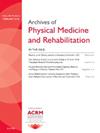美国脑卒中后康复在获取、使用和质量方面的差异:范围审查》。
IF 3.6
2区 医学
Q1 REHABILITATION
Archives of physical medicine and rehabilitation
Pub Date : 2025-05-01
DOI:10.1016/j.apmr.2024.10.010
引用次数: 0
摘要
目标:总结目前有关脑卒中后康复差异的文献报道,找出我们对康复差异认识的不足,并为未来研究提出建议:一名健康科学图书管理员根据事先制定的协议开发了一个检索字符串,并检索了 MEDLINE(Ovid)、Embase(Elsevier)和《护理与联合健康文献累积索引》(CINAHL,EBSCO):研究筛选:先对标题和摘要进行两步筛选,然后进行全文审阅。保留了在美国进行的、报告成人中风后康复(即物理、职业或语言治疗)差异的主要观察性研究。符合条件的差异人群包括少数种族、少数族裔、少数性别、老年人口、社会经济弱势人群和少数地域(城市内/农村):从保留的文章中提取的数据包括:目的/目标;数据来源;样本特征;研究的康复结果;研究的差异类型;使用的统计方法;差异研究结果。数据综合:筛选了 7853 篇标题和摘要,对 473 篇文章进行了全文审阅。共纳入 49 篇文章进行数据提取和分析。许多文章研究了一种以上的差异类型,大多数文章研究了种族和/或民族差异(43 篇,87.7%),其次是性别(25 篇,53.0%)、年龄(23 篇,46.9%)、社会经济地位(22 篇,44.9%)和城市/农村地位(8 篇,16.3%)。文章的样本特征、数据来源、康复结果和研究差异的方法差异很大:虽然我们发现了一些一致的证据,表明老年人、非白人种族和社会经济地位较低的人在康复方面存在差异,但由于方法不同,综合研究结果具有挑战性。为了更好地了解中风后康复差异的程度,还需要进一步的工作,包括更多设计良好的研究以及对现有研究进行系统回顾和/或荟萃分析。本文章由计算机程序翻译,如有差异,请以英文原文为准。
Disparities in Access to, Use of, and Quality of Rehabilitation After Stroke in the United States: A Scoping Review
Objectives
To summarize current reports in the literature on disparities in rehabilitation after stroke; identify gaps in our understanding of rehabilitation disparities; and make recommendations for future research.
Data Sources
A health sciences librarian developed a search string based on an a priori protocol and searched Medline (Ovid) Embase (Elsevier), and the Cumulative Index to Nursing and Allied Health Literature (CINAHL and EBSCO).
Study Selection
A 2-step screening process of titles and abstracts followed by full-text review was conducted. Primary observational studies conducted in the United States that reported on disparities in rehabilitation (ie, physical, occupational, or speech therapy) among adults after stroke were retained. Eligible disparity populations included racial minorities; ethnic minorities; sex and gender minorities; older populations; socioeconomically disadvantaged populations; and geographic minorities (inner city/rural).
Data Extraction
Data extracted from retained articles included: aims/objectives; data source; sample characteristics, rehabilitation outcomes examined; types of disparities examined; statistical methods used; and disparity findings.
Data Synthesis
Seven thousand eight hundred fifty-three titles and abstracts were screened, and 473 articles underwent full-text review. Forty-nine articles were included for data extraction and analysis. Many articles examined more than 1 disparity type with most examining disparities in race and/or ethnicity (n=43, 87.7%), followed by sex (n=25, 53.0%), age (n=23, 46.9%), socioeconomic status (n=22, 44.9%), and urban/rural status (n=8, 16.3%). Articles varied widely by sample characteristics, data sources, rehabilitation outcomes, and methods of examining disparities.
Conclusions
Although we found some consistent evidence of disparities in rehabilitation for older individuals, non-White races, and individuals of lower socioeconomic status, the variability in methods made the synthesis of findings challenging. Further work, including additional well-designed studies and systematic reviews, and/or meta-analyses of current studies, is needed to better understand the extent of rehabilitation disparities after stroke.
求助全文
通过发布文献求助,成功后即可免费获取论文全文。
去求助
来源期刊
CiteScore
6.20
自引率
4.70%
发文量
495
审稿时长
38 days
期刊介绍:
The Archives of Physical Medicine and Rehabilitation publishes original, peer-reviewed research and clinical reports on important trends and developments in physical medicine and rehabilitation and related fields. This international journal brings researchers and clinicians authoritative information on the therapeutic utilization of physical, behavioral and pharmaceutical agents in providing comprehensive care for individuals with chronic illness and disabilities.
Archives began publication in 1920, publishes monthly, and is the official journal of the American Congress of Rehabilitation Medicine. Its papers are cited more often than any other rehabilitation journal.

 求助内容:
求助内容: 应助结果提醒方式:
应助结果提醒方式:


